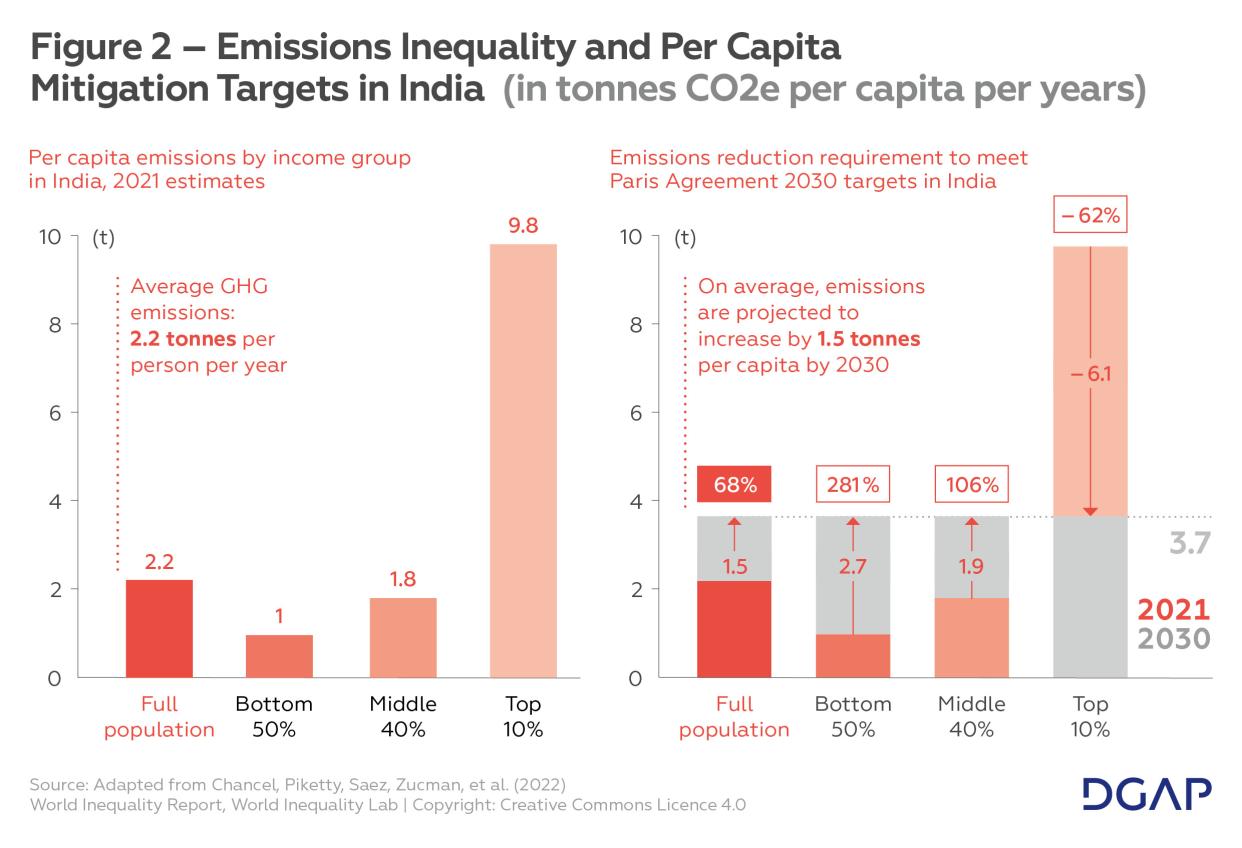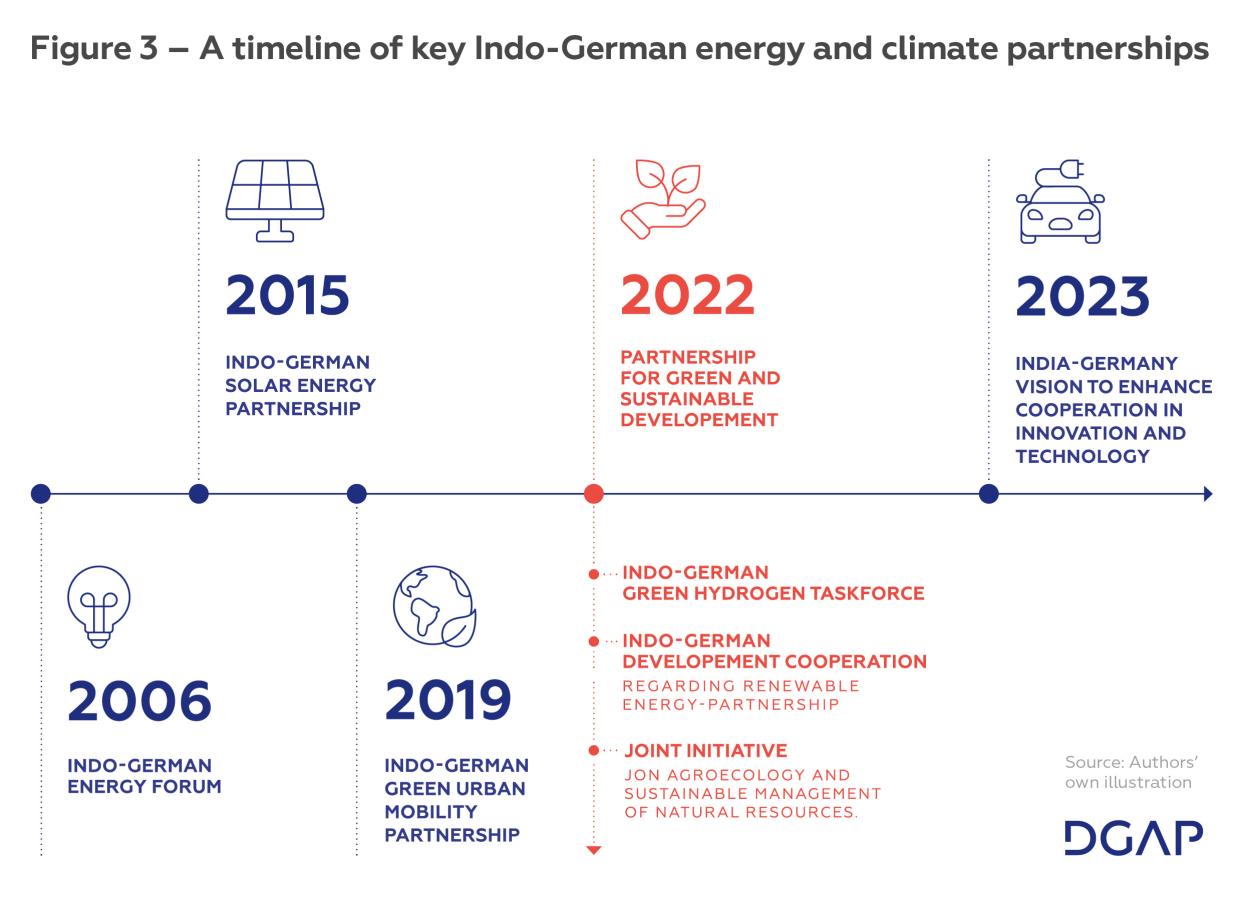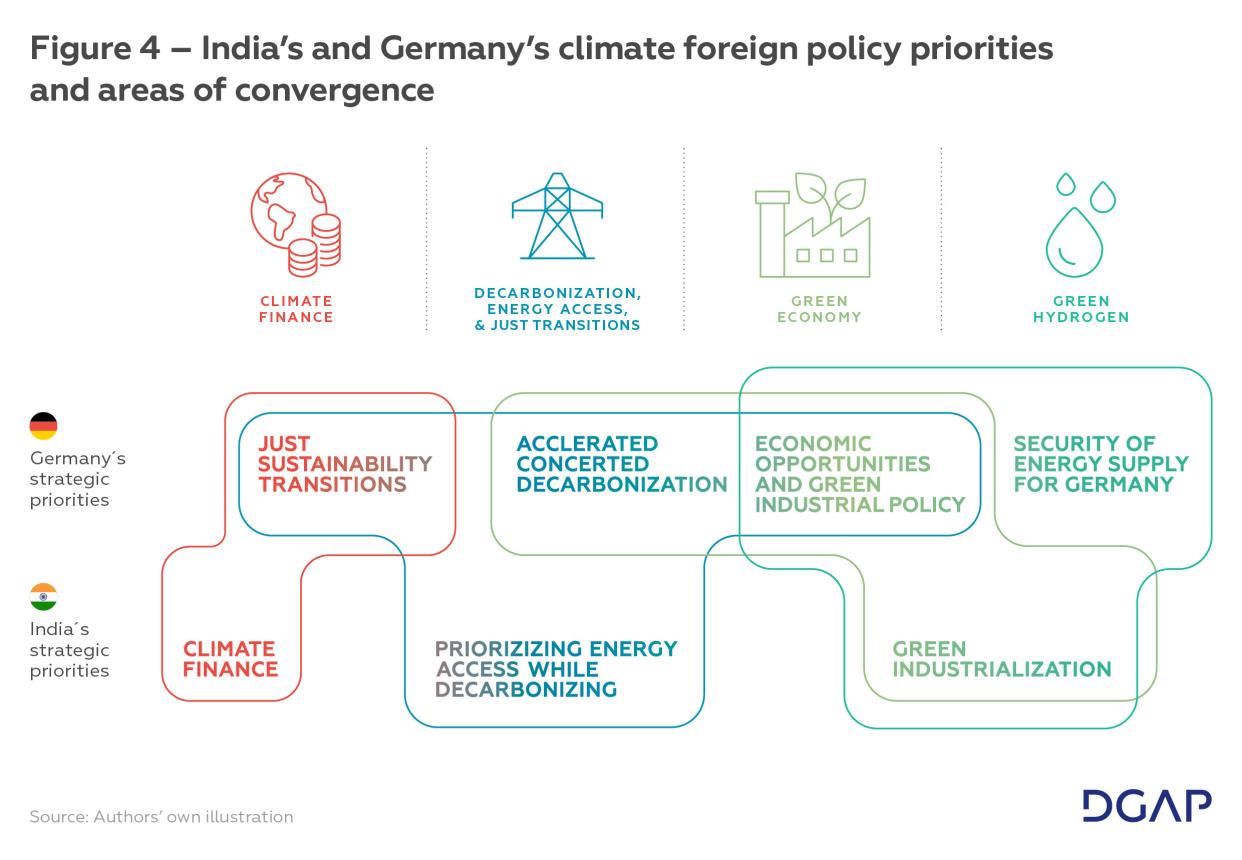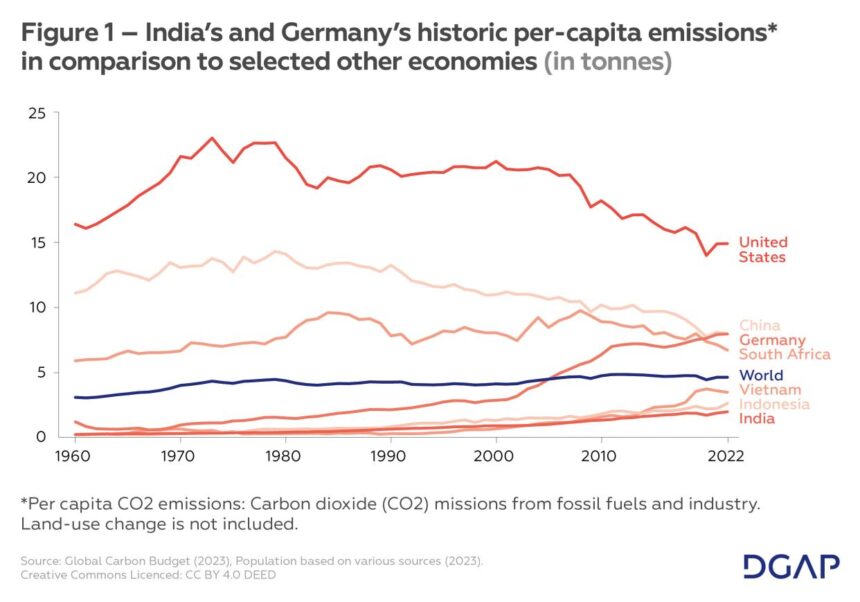| Our analysis reveals significant overlap in India’s and Germany’s strategic priorities regarding (a) green industrialization, (b) production and trade of green hydrogen, (c) climate justice, in particular improving energy access, and (d) climate finance. |
| While there is broad consensus on the need for a “just transition,” there are nuances in terms of the perceived roles and responsibilities considering the historical contributions to climate change and its uneven effects. |
| Both countries view green hydrogen as one important element in their energy security and broader economy-wide green transformation. Partnerships in this area should lead to the development of green hydrogen technologies, resolving bottlenecks, defining standards, and establishing broader frameworks including for trade. |
| While Germany has committed substantial public finance for climate change mitigation in India, innovative financing models with the involvement of the private sector are needed. |
This policy brief does not contain footnotes. To view the footnotes, please download the pdf version here.
Germany and India
Climate Change Priorities and Partnership Opportunities
Considering the wide distribution of greenhouse gas emissions across countries and sectors, the scale of action required to meet the goals of the United Nations’ Paris Agreement and 2030 Agenda, and insufficient progress in international climate negotiations, partnerships beyond the multilateral governance process are an increasingly important instrument for implementing climate targets. In this policy brief, we analyze the energy and climate partnerships between India and Germany. We first identify each country’s national priorities in relation to climate change mitigation.
For several reasons, we do not assess other important areas such as climate adaptation or biodiversity conservation. First, as the third and eighth largest emitters, respectively, India and Germany are vital to reducing global emissions in line with the goals of the Paris Agreement. Second, the size of India’s and Germany’s economies and their experiences in the green transition means that the two countries may share experiences and mobilize economies of scale when it comes to mitigation solutions. Third, mitigation action presents a business case that may have significant co-benefits for the two countries’ respective geo-economic interests, positioning them as leaders on issues like green value chains or industry decarbonization.
Germany’s Climate Foreign Policy
Connecting Emissions Mitigation with Strategic Interests and Values
The German Climate Foreign Policy Strategy released in December 2023 considers a range of instruments, including bilateral and multilateral partnerships, to advance climate mitigation and a global energy transition. The German government aims to embed international decarbonization action into a broader strategic approach, connecting emissions mitigation with geoeconomic and geopolitical interests as well as a values-based approach to foreign policy. Building on a review of government documents in a previous DGAP policy brief, we identified four strategic policy priorities that the federal government pursues through its partnership engagement in energy and climate action:
- An accelerated, concerted decarbonization, notably by supporting a supply switch from fossil fuels to renewable energy and electrification, entailing the build-up of renewables and creating affordable exit options for fossil infrastructure
- Security of domestic energy supplies, in particular through foresighted imports of Liquified Natural Gas (LNG) and different forms of hydrogen (H2)
- Securing access to foreign markets and creating economic opportunities for German companies, building decarbonized trade relationships and supply chains, and pursuing a green industrial policy
- Supporting just sustainability transitions abroad, particularly by including all relevant stakeholders and marginalized groups, in line with Germany’s values- and human-rights based foreign policy approach, including links to feminist foreign policy
- GERMANY´S CLIMATE DIPLOMACY
-
Germany has historically aimed to position itself as a leader in international climate policy. In the EU, the country was a vocal proponent of the ratification of the Kyoto Protocol, which established binding emissions mitigation targets for developed countries, thereby recognizing the special responsibility of historic emitters. Having been among the first countries to establish targets for emissions mitigation in 1990, the government set the goal of reducing greenhouse gases covered by the Kyoto Protocol by 21 percent compared to the 1990 baseline – a higher ambition than the EU average. However, the 1990s and 2000s were marked by a postponement or erosion of ambitious targets due to opposition from various political and interest groups, illustrating corporatist environmental decision-making style.”
Despite initial skepticism among German industry and politics, EU member states decided to create an emissions trading system (ETS) targeting energy-intensive industry, in line with the flexible market-based focus of the Kyoto Protocol. While it did set the EU on a long-term path to emissions mitigation, the ETS has been criticized for targeting only specific sectors and being too lenient to incentivize ambitious climate mitigation. A more holistic approach was developed following the adoption of the Paris Agreement, with the system of nationally determined contributions (NDCs) emphasizing domestic policies. The EU Green Deal emerged as an economy-wide strategy to achieve climate neutrality by mid-century. Under the German presidency of the Council of the EU in 2020, EU heads of state and government agreed to increase the 2030 target to an emissions reduction of at least 55 percent over 1990. The legislation package includes regulatory approaches, a stricter ETS for industry, as well as an additional ETS for buildings and the transport sector.
The framework at the domestic level is Germany’s climate protection law. After the existing law was declared partly unconstitutional by the Federal Constitutional Court in a “revolutionary climate ruling,” the government presented a revised proposal adopted by parliament in 2021. It foresees emissions mitigation of 65 percent by 2030 compared to 1990 levels (a 10 percent increase from the previous law), with the aim to reach climate neutrality by 2045.
Latest scientific assessments reveal that while domestic emissions are projected to decrease significantly in the coming years, these efforts are insufficient to meet the 2030 mitigation targets. One central element of Germany’s energy transition is the phase-out of domestic lignite and hard coal production by 2038 at the latest. As the consensus on this goal has solidified following a bargaining agreement with energy utilities and union groups, Germany hopes to share experiences internationally.
Internationally, the government has been emphasizing plurilateral coalitions beyond the multilateral process, including through initiatives such as the intergovernmental Climate Club that aims to advance sectoral decarbonization. Germany is one of the largest providers of climate finance, having contributed approximately EUR 6 billion in 2022. Germany is urging other industrialized countries to follow suit to attain the goal of providing USD 100 billion annually in international climate finance. As climate finance is being re-negotiated in the run-up to COP29, government officials have been emphasizing the responsibility of large emerging economies with rising emissions, notably from the G20.
India’s Climate Diplomacy
Navigating Climate and Development Considerations
India’s historical emissions have been low, accounting for around four percent of total global emissions since the industrial revolution. However, India is currently the fastest growing large economy with an annual growth rate around eight percent. As India grows, so do its emissions, with the International Energy Agency estimating that energy demand and associated emissions could increase by 30 percent by 2030. At the same time, India’s per capita emissions remain much below the global average (seefigure 1).
Since the 1990s, India’s positioning on international climate policy has undergone significant change. It has increasingly committed to internationally coordinated emissions mitigation in its economic development pathway, while still invoking the principle of Common But Differentiated Responsibilities (CBDR) (see info box 2). Several factors have shaped this dynamic. First, there has been an increased recognition of the vulnerabilities India faces with rapidly increasing climate change and therefore a greater urgency to act in its own interest. Second, the rapid technological improvements and reduction in the cost of green technologies, particularly renewable energy, as well as India’s substantial solar and wind energy potential have created a business case for greater mitigation action. Third, and perhaps most importantly, there has been greater recognition that climate action can have substantial economic co-benefits. For instance, the promise of reducing external energy dependence has been a key argument for the policy push for renewable energy. Climate finance is also now seen as more than just a means to divert funds from other development projects; it is increasingly recognized as an additional source of financial inflow. Finally, as India aims to wield greater influence on the global stage, there has been a recognition of the need to adopt a more positive and assertive stance in its climate diplomacy.
Understanding the motivation for India’s climate diplomacy is important to frame effective partnerships. Based on our analysis, India’s climate priorities can be broadly grouped into the following categories:
- Prioritizing energy access while decarbonizing: Ensuring affordable and reliable energy for over half of India’s population facing energy poverty remains the top priority in the country’s energy policy. As a result, while India has ambitious clean energy targets, any international partnership must be cognizant of India’s need to provide round-the-clock affordable power to all its citizens, a need that is largely met by coal-based thermal power at present. For instance, India’s National Electricity Plan estimates that while renewable energy will account for 62.4 percent of installed capacity by 2030, coal-based thermal power will continue to be the dominant source of power, accounting for 54.5 percent of generation.
- Green Industrialization: A key prong of India’s economic strategy is to grow the share of the industrial sector in GDP. Green technologies are seen as a key enabler of these industrialization efforts, with concerted efforts to create local production capabilities. India already has various performance-linked incentive (PLI) schemes for green technologies such as electric vehicles, solar modules, battery storage, green hydrogen, and electrolyzers. These schemes provide sales-based monetary incentives for selected firms producing these products. Efforts are also underway to cultivate a skilled labor force for emerging industries and create conditions for a just transition for workers in sunset fossil fuel sectors. These priorities could serve as important entry points for any viable international partnership.
- Access to Climate Finance: India’s large clean energy infrastructure buildup will depend heavily on the influx of international private capital, as highlighted consistently in its international negotiating positions. However, at present, most climate projects in India are financed through domestic sources. The high cost of international capital due to perceived economic, currency, and political risks continues to hamper the energy transition. International partnerships should focus on establishing platforms to reduce the cost of green capital either through identifying new risk assessment measures or utilizing public finance to derisk private capital flows into the country.
- INDIA’S CHANGING CLIMATE DIPLOMACY
-
India’s climate diplomacy has always been strongly influenced by its broader developmental challenges. As early as 1990, Indian climate negotiators stressed that the country considered the United Nations Framework Convention on Climate Change (UNFCCC) a “multilateral economic agreement” that could significantly affect economic development, rather than solely an environmental treaty. As India’s economic circumstances have evolved, so has its climate diplomacy. In the early stages of the UNFCCC process, India took the position that poverty eradication and economic development were the main objective of developing nations and called for “per capita convergence” in emissions between developing and developed economies. In the period leading up to the 1992 Rio conference, India successfully brought together effective alliances with developing countries to ensure that the principle of common but differentiated responsibilities and respective capabilities (CBDR-RC) was enshrined in the UNFCCC.
Ahead of the ratification of the Kyoto Protocol, India took two major stances in its climate diplomacy. First, it proposed a firewall between developed and developing countries, requiring the former to stabilize emissions at 1990 levels by 2000 due to historical responsibilities, while exempting developing countries from binding commitments. Second, it stated the incremental costs associated with any additional climate action in developing countries would have to be met by the developed world. Between the ratification of the Kyoto Protocol in 2005 and the adoption of the Paris Agreement in 2015, India’s stance evolved significantly. It became increasingly open to embracing emissions reduction commitments, marking a notable departure from its previous hardline position. In 2008, India introduced the National Action Plan on Climate Change that emphasized achieving development goals while generating co-benefits for climate change mitigation. Additionally, in 2009, then-environment minister Jairam Ramesh announced India’s aim to reduce the emission intensity of GDP by 20-25 percent by 2020 from 2005 levels, marking a significant departure from its previous reluctance to define specific emission targets.
Since the Paris Agreement, India has aimed to position itself as a leader in climate action while prioritizing the principle of CBDR and advocating for increased financial and technological support from developed countries. India set an economy-wide net-zero emissions target by 2070 at COP26. In addition, India is one of the few countries to achieve its original NDCs related to reducing the emission intensity of GDP and achieving 40 percent cumulative electric power installed capacity from non-fossil fuel-based energy sources. Currently, India ranks fourth globally in terms of total renewable energy installed capacity (around 175 GW), a substantial achievement for a developing economy. At COP27, India put forward an updated NDC, including a more ambitious target to reduce the emission intensity of GDP by 45 percent from 2005 levels by 2030. Perhaps the most ambitious commitment is its pledge to increase installed renewable energy capacity to 500 GW by 2030. Achieving this goal would require India to install more renewable energy capacity in this decade than the country’s current total installed electricity capacity, fulfilling the commitment to triple renewable capacity by 2030.

- CONTEXTUALIZING INDIA’S CARBON EMISSIONS
-
As a developing country, India’s per-capita emissions have historically been low. While per-capita emissions have grown at a steady pace since the 1950s and doubled in the 2000-2022 period, they are still lower than those of other major emerging economies like South Africa, Indonesia or Vietnam and four times lower than those of Germany (see figure 1). Taking the emissions pathways to meet the Paris Agreement as a yardstick, domestic emissions would continue to increase from the current 2.2 tons per capita to about 3.7 tons in 2030.
India is characterized by significant domestic carbon inequality, with most of its population in the bottom 50 percent of global emitters, and a sizable portion in the middle 40 percent. A small but growing share occupies the top 10 percent of global emitters. This implies that the pressures to limit emissions in India are distributed unequally. If expressed in per-capita terms, 2030 emissions reduction requirements as per the Paris Agreement would imply an increase of emissions for most of the population. By contrast, the top 10 percent of domestic emitters would need to significantly reduce their emissions (see figure 2).
Both in Germany and in India, current growth rates of renewable energy installment do not match up with the respective tripling targets endorsed by governments at COP28. The wider EU is not on track to meet the tripling target either. Therefore, increased national policy interventions and international partnerships are needed to accelerate climate mitigation action. Conscious of the distinct socio-economic contexts and the principle of CBDR, we provide a brief overview of bilateral partnerships, describe the synergies and challenges that define them, and consider how Germany and India may shape them going forward.
Two Decades of Indo-German Energy and Climate Partnerships
Germany and India share a long history of intergovernmental and economic relations, with India among the first countries to establish diplomatic ties with the Federal Republic of Germany after the Second World War. Milestones in Indo-German relations since the turn of the century include an agreement declaring the two as strategic partners in 2000, the launch of the Inter-Governmental Consultations (IGC) in 2011, and the conclusion of the Partnership for Green and Sustainable Development in 2022. Throughout this period, the two countries have worked to address climate change and implement clean energy transitions.
The establishment of the Indo-German Energy Forum (IGEF) in 2006 makes India one of Germany’s longest-standing partners on climate action and energy transitions. The forum has since facilitated bilateral cooperation in the areas of sustainable energy, energy efficiency, energy security, and private sector collaborations. Germany and India have collaborated through Germany’s International Climate Initiative (IKI), which was established in 2008.
In 2015, the two sides agreed on an Indo-German Solar Energy Partnership (IGSP) worth EUR 1 billion with an aim of promoting the uptake of solar photovoltaic (PV) energy. Solar energy is expected to make up well over half of the 500 gigawatts (GW) of non-fossil energy India aims to install by 2030.
In 2022, in a landmark development, the new German government and the government of India signed several important documents. Following the 6th IGC, they signed a total of 14 agreements, with several on climate action and energy transitions. The key agreement was the Indo-German Partnership for Green and Sustainable Development in which the two countries pledged to intensify their collaboration on climate action and sustainable development to achieve the Paris Agreement targets and the UN’s Sustainable Development Goals (SDGs): “[t]he Partnership will continue to include and further strengthen collaboration between the public and private sectors, civil society organizations and research institutions.”
One element of this partnership is a joint declaration of intent on renewable energy cooperation. Officially the Indo-German Renewable Energy Partnership, it is the successor and a broader adaptation of the 2015 Indo-German Solar Energy Partnership. India and Germany hope this will help them realize their goals of producing 40 percent (recently updated to 50 percent) and 80 percent, respectively, of their electricity from non-fossil sources by 2030. Moreover, the 2022 Indo-German Green Hydrogen Task Force will facilitate relations between government, industry, and research institutions to promote the production, processing, utilization, and transport of green hydrogen.

In February 2023, when Chancellor Olaf Scholz visited India, the governments agreed on an “India-Germany Vision to Enhance Cooperation in Innovation and Technology” which contains a clause on energy partnerships and clean technologies, including green hydrogen. In a step toward realizing this vision, India’s Department of Science and Technology (DST) and Germany’s Fraunhofer Institute for Solar Energy Systems (Fraunhofer ISE) signed a letter of intent to collaborate on green hydrogen and clean energy technologies.
Analysis
How Existing Energy and Climate Partnerships Align with the Two Countries’ Climate Foreign Policy Priorities
Based on our analysis of each country’s priorities, we find substantial overlap between India’s and Germany’s strategic priorities in the climate and energy domain. The following four broader themes emerged that capture their shared priorities (see figure 4): (a) decarbonization, energy access, and just transitions; (b) green economy; (c) hydrogen; and (d) climate finance. This section analyzes existing partnerships along these themes.
First, Germany’s interest in decarbonization and green industrial policy aligns with India’s interest in promoting domestic green industrialization. The wording of the different agreements and planned activities show the urgency for decarbonization and renewable energy expansion. For instance, all four IGEF focus areas address decarbonization in relation to renewable energy expansion, energy efficiency, flexibilization of coal-fired power plants, and green energy financing and grid integration. The 2022 Partnership for Green and Sustainable Development aims “to intensify bilateral climate and sustainable development cooperation and link it with the strong commitment on both Participants to the SDGs and the implementation of the Paris Agreement.” It establishes the expansion of renewable energy capacities, sustainable urban development, and green mobility as areas for bilateral cooperation. Technology innovation, regulatory standards, capacity building and private investments are particular areas of engagement, with one focus area being the build-up of solar photovoltaic (PV) manufacturing capabilities.
The 2022 Renewable Energy Partnership goes beyond the focus on solar PV and aims to “promote a wide spectrum of renewable energy applications, ranging from small-scale off-grid solutions to large-scale solar parks, wind energy parks and offshore wind.” Documents from 2022 and 2023 contain a stronger emphasis on decarbonization than earlier ones, reflecting a growing urgency among partnerships to act. Energy generation, distribution and efficiency have emerged as the largest areas of funding in India for Germany’s KfW development bank, with around EUR 744 million committed to this sector. Gaining a competitive edge in the green transition appears to be a motivation as well. Recognizing the increasingly intense competition in clean technologies, existing partnerships frequently focus on technological cooperation and joint research and development between industry, the private sector, and research institutions.
Second, the promotion of hydrogen markets and trade has emerged as a focal point for cooperation, with activities aimed at engaging policy makers, business, and other stakeholders. For instance, under the IGEF, there have been technical cooperation and capacity building programs, as well as training activities related to green ammonia supply chains, green hydrogen electrolyzer and fuel cell installations, and the identification of green hydrogen hubs in India. The Partnership for Green and Sustainable Development foresees hydrogen as a particular field for collaboration. Areas of focus include technology innovation, regulatory standards, capacity building and private investments. Aiming to position itself as a future producer and exporter of green hydrogen as part of a green industrialization agenda, India connects this action area with economic opportunities and green growth. For Germany, it is seen as a measure to enhance energy security, with hydrogen being considered as an important element in Germany’s future energy mix. At the same time, it may also serve its green industrial policy as Germany aims to secure hydrogen supplies for heavy industry (e.g., green steel) and other hard-to-decarbonize sectors. Beyond hydrogen production capacities and related trade, it appears that energy security considerations have not prominently featured in Indo-German partnerships. One explanation for this is the two partners’ limited potential to contribute to each other’s security of supply through, for example, raw materials.

Third, there is an overlap between Germany’s emphasis on just transitions and India’s priority to ensure energy access while pursuing decarbonization. Improving energy access is rarely mentioned explicitly in the agreements; however, significant activities have been carried out in this regard. Most importantly, through the provision of loans, the German Ministry for Development Cooperation (BMZ) has been supporting the establishment of green energy corridors to feed renewables capacity into India’s national grid. According to the BMZ, “7,770 kilometres of green energy corridors have been established, providing around 40 million people with electricity from renewable energy sources.” Integration of renewables into the power mix continues to be a priority under the 2022 Solar Partnership under which the BMZ has committed to providing another EUR 1 billion by 2025. The 2019 Partnership for Green Urban Mobility has described improved access to public transport and climate friendly mobility as a way to create “economic and social opportunities,” with German development organization GIZ providing technical assistance to design “sustainable, inclusive and smart solutions for easy and affordable mobility,” and the KfW development bank committing concessional loans to fund such measures. New opportunities may be created through the 2022 Partnership for Green and Sustainable Development, which defines as one of its focal areas “a just energy transition” and mentions collaboration with and among civil society organizations.

Finally, India’s need for climate finance is reciprocated by Germany’s justice-oriented climate foreign policy approach. While India and the Global South broadly have reasons to complain about the shortage of climate finance, Indo-German partnerships have provided India with notable financial support in the past and promise to continue doing so in the future. For instance, Germany has committed to providing India with EUR 10 billion by 2030 within their 2022 Partnership for Green and Sustainable Development. Similarly, the 2015 Indo-German Solar Energy Partnership provided India with approximately EUR 1 billion in the form of concessional loans.
Recommendations
Deepening and Operationalizing Partnerships
Given the need to speed up implementation of the Paris Agreement, the geopolitics of competition with China and increased volatility in energy prices since Russia invaded Ukraine, Germany and India should deepen ties on climate ambition. While both have advanced their joint effort on climate and energy issues through multiple initiatives, there are several areas that offer potential for closer cooperation. Building on existing initiatives, we propose the following recommendations in key areas to deepen their partnership:
Green Economy
To achieve an economy-wide green transformation, India and Germany can leverage their partnerships in areas including, but not limited to:
- Co-development of green technologies in promising sectors such solar modules and battery storage, particularly through effective platforms that allow academia and industry to exchange data and expertise.
- Aligning green industrial policy to cooperate on green technology trade and maximize benefits from the comparative advantage of each country. Both countries can also take steps to align national policies on emissions reduction, sustainable resource management, and climate-smart agricultural practices.
- Advancing climate mitigation in third countries through greater collaboration in existing plurilateral forums such as the International Solar Alliance and the Coalition for Disaster Resilient Infrastructure.
- Collaborating to foster dialogue between India, other developing countries, and the EU to iron out issues in implementing the EU’s Carbon Border Adjustment Mechanism (CBAM).
Green Hydrogen
Both countries view green hydrogen as one important element in their energy and broader economy-wide green transformation. India recently established its Green Hydrogen Mission, while Germany has also prioritized hydrogen in its domestic policies as well as part of the Climate Club:
- Hydrogen Economy: The two countries should work together, bilaterally and in plurilateral settings, to establish the underpinnings of a green hydrogen economy. This includes standard definitions for the diverse types of hydrogen, creating common rules for hydrogen transport and trade, aligning policies, and creating demand through industry mandates or economic incentives.
- Collaboration Platform: India and Germany could work together to build a platform that brings together policymakers and industry to identify a viable pathway for green hydrogen production, use, and trade. The platform could support knowledge sharing and co-development of green hydrogen technologies, joint ventures to catalyze the hydrogen market, and resolving key bottlenecks that hinder demand for hydrogen. For instance, opening a H2-diplo office – a German government initiative to work with partner countries to use green hydrogen and diversify their economies – in India can be a first step.
Decarbonization, Energy Access, and just Transitions
Indo-German partnerships in the past have consistently prioritized decarbonization with a focus on green technologies such as renewable energy and public transport, among others. To maximize benefits from future partnerships, it is crucial to now concentrate on sectors with potential to synergize energy access and decarbonization efforts, and where there is already significant policy momentum in India.
- Rooftop Solar: Partnerships on rooftop solar could focus on both knowledge and resources. Germany’s success with rooftop solar could hold important policy lessons for India. Furthermore, through institutions like the KfW, there is potential to develop programs that could aggregate smaller consumers and offer financial guarantees. These programs would encourage private investors and developers to provide affordable financing to smaller consumers, who typically have lower credit ratings.
- Grid Stability and Storage: India will need to install around 35 GWh of Battery Energy Storage Systems by 2027 for the effective integration of renewables into the grid, requiring immediate large-scale investment in this sector. The Indian government already has a PLI scheme for battery storage systems and aims to provide INR 36.7 billion (USD 400 million) in viability gap funding for base year costs for utility-scale battery energy storage system (BESS) projects. Germany’s capacity build-up has been largely due to small-scale private home storage, with large-scale and industry storage capacity growing at a much slower pace. While the regulatory environment plays an important role, further policy instruments still need to be clearly defined. The Indo-German climate partnership could significantly enhance its focus on BESS projects to maximize the benefits of renewable energy and facilitate a transition away from thermal power. An initial step could be to establish an industry collaborative dedicated to advancing R&D in battery storage technologies and promoting cross-country learning, with the goal of reducing BESS costs. Additionally, there is potential to create a dedicated BESS fund to finance further R&D and complement funding initiatives for viability gaps. Moreover, electricity regulators and policymakers from both countries could work together to identify and implement best practices for integrating BESS into the energy grid, enhancing both efficiency and sustainability. Efforts to improve transmission and grid infrastructure help mitigate sector-specific investment risks and may also incentivize domestic and private investments in renewable energy projects.
There are certain nuanced differences between the German and Indian approach to just transitions that are important to consider in any future partnership. Notably, the Indian strategy extends beyond merely providing alternative livelihoods for those affected by the coal industry’s transformation, linking just transitions to broader issues of energy security, poverty reduction, and climate finance. Viewed from this lens, a just transition partnership needs to focus explicitly on using renewables to improve energy access, reducing demand for thermal power, and creating a skilled labor force for the new energy economy.
- Skilling programs: Indo-German partnerships should focus on key skills needed in a renewable energy economy and devising programs to reskill and upskill the labor force to access renewable energy jobs, especially in regions with high coal dependency.
- Support for sub-national transitions: Many coal-dependent states in India will see a substantial portion of their coal mines and thermal power plants reach the end of their life cycle in the next decade. German development agencies may partner with willing states to financially support the economic diversification of districts dependent on coal. This could help to create new income-generating activities while the world is “transitioning away from fossil fuels in energy systems, in a just, orderly and equitable manner,” as agreed at COP28. Support can take two forms: i) providing dedicated human resources to state government departments for creating economic diversification roadmaps and ii) financial support for specific projects looking to create alternative jobs in coal dependent regions.
Climate Finance
Germany provides substantial public finance for climate action in India – especially under the Partnership for Green and Sustainable Development, as well as KfW’s development finance schemes.
Develop innovative climate financing: In addition, German and Indian policymakers should work together to incentivize private capital flows with instruments such as guarantees or insurance products. They should consider innovative financing models including blended finance (i.e., a combination of concessional funds with commercial finance) and debt-to-climate swap and promote these models in the context of reforming the international financial system.
Source: German Council on Foreign Relations (DGAP)







